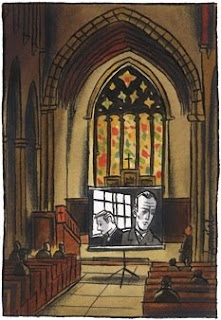The role of reason in beliefs and disbeliefs
After the movie both friends are subjected to a talk by the church minister and a painting of Jesus, "The Light of the World". The main point of the NewYorker story, however, is about the diametrically opposite reactions to seeing this religious painting:I wasn’t a churchgoer, nor was Rob, but neither of us had seen the movie, and, after all, it was Bergman, and free, so we went. The church was cold. There couldn’t have been more than twenty-five, thirty of us scattered around the pews in our overcoats and scarves.
...
After the first scoffing murmurs of recognition—the opening scenes of the film show a cold-looking church with a few parishioners in overcoats—we all settled down. You simply cannot be ironical in the face of this movie, its adamant seriousness, the unguarded, naked urgency of its story, and the challenge it presents both to believers and to skeptics to assess the depth and consequences of their convictions.
Tomas, a Lutheran pastor and widower, is suffering a crisis of faith, barely going through the motions of his ministry; indeed, he can’t even find the heart to treat his lover, a schoolteacher, with kindness. One of his parishioners has become obsessed with the prospect of nuclear annihilation. At his wife’s urging, this man, a fisherman, comes to the pastor for reassurance, some blessed word of hope that he can grasp as a lifeline, but Tomas can offer nothing but the bleakness of his own despair. The fisherman commits suicide. Yet Bergman takes care to show that Tomas and the fisherman are not alone in their suffering, and that others, equally afflicted—the fisherman’s wife, the pastor’s steadfast lover, his hunchbacked assistant—are able to bear their pain into a still deeper faith and capacity for love.
Because I really disliked that painting. It seemed to me a typical Pre-Raphaelite production: garish, melodramatic, cloying in its technique and sentimentality; pretentious humbug. The contrast between Bergman’s severe, honest art and this painting, on the same screen, chilled me. Was this what the minister held in his mind as the answer to all our problems—a kitschy figure from a calendar? I turned to Rob. “Let’s get a pint.”
But Rob was intent on this very image. Rapt. He barely glanced at me. “You go on.”
That night—to some extent, that picture—changed his life. He enrolled in Bible classes at the church, and went on to become a missionary in Africa. The same night sent me in the opposite direction, at least for a time. But would a different painting—Caravaggio’s “Conversion of St. Paul,” for example—have kept me in the pew? We like to think of our beliefs, and disbeliefs, as founded on reason and close, thoughtful observation. Only in theory do we begin to suspect the power of aesthetics to shape our lives.
This is a good observation. But, of course, the role reason plays in one's worldview is very different from person to person. More interestingly, what about the role of reason for people who move from belief to disbelief after reading Sagan, Dawkins, or Gould? I think there is no need to count out reason completely.
Read the full story here.




.jpg)





0 comments:
welcome to my blog. please write some comment about this article ^_^